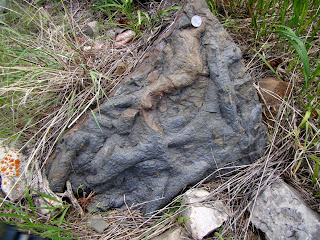The archaeologists were interested in the fact that we had arrived in the ancestral lands of the Plains Indians, and indeed since we had left Glacier National Park, we had been on the Blackfeet Indian Reservation. The billboard that greeted us at the edge of town was an acknowledgement that we were in the home of a different culture.
Our first stop was Museum of the Plains Indians in Browning. The museum (which did not allow photography) was filled with exhibits of Native American arts, and is well worth a visit.
At Browning, the landscape was irregular, with numerous small hills and isolated ponds. The hummocky topography is the result of the passage of continental glaciers moving south out of Canada. As we drove south, the shape of the land became more "normal" (for us Californians, anyway), with gullies and valleys carved by stream erosion. The Rocky Mountains remained in sight, off to the west.
At the small village of Choteau, we paid a visit to their modest museum, and had a look at some dinosaur specimens, including the display below on dino eggs. The region around Choteau is remarkable for two reasons. Excavations started in the 1970s revealed numerous dinosaur nesting sites, which were used repeatedly for tens, maybe hundreds of thousands of years. Not only were the eggs themselves important, but also the behaviour of the dinosaurs that laid them. Work by Jack Horner and others demonstrated that the Maiasaurs took care of their young, and that they moved in herds.We didn't have the time to arrange a trip to nearby Egg Mountain, so we settled for the displays.
Outside of the town of Augusta, we headed west towards Sun Canyon for a look at some remarkable Rocky Mountain geology. That glaciers had once emerged from the canyon onto the plains was immediately apparent, as the road traversed the rocky slopes of the terminal moraines.
Soft Cretaceous sediments were apparent in the streamcuts. In the picture below one can see a sweet little anticline, an upward pointing fold. The mountains loomed higher and higher as we continued west. And something was odd about them...
As can be seen in the picture below, there are two sets of prominent cliffs at different levels. They are made of the same rocks! The geology was repeating itself. It wasn't just once. As we drove up the canyon, the same carbonate rocks were repeated at least five times.
What we were seeing was another manifestation of the extreme compressional forces that resulted from the convergence of the North American continent with the oceanic crust of the Pacific Ocean basin. In latest Cretaceous and early Cenozoic time (70-50 million years ago), the crust was disconnecting from the underlying basement rocks in a series of blocks that were sliding up and over each other in a series of overthrusts. At least twenty such thrusts occurred in this part of the Rocky Mountains, and we drove past five of them.
The outcrops and the scenery were incredible...
An additional point of interest for us...the carbonate rocks formed in a shallow sea in Devonian and Mississipian time, and were full of fossils of marine life, like crinoids, brachiopods, corals, and bryozoans. The students spent some time searching for the evidence of past life.
As we drove back down the canyon, we were reminded why creeks and rivers were flooding all over Montana and the Great Plains. There was still a tremendous, even unprecedented amount of snow left in the high country, and small reservoirs, like Diversion Lake, seen below, were filled to overflowing.
Going down canyon, we were given a different perspective on the repeating structural blocks.We made one more stop in the lower canyon, looking for some ammonites. We instead found these strange burrowing structures in the Cretaceous rocks. They were identified by my Twitter colleagues as Thalassinoides burrows, something akin to burrowing crayfish or shrimp. They were huge! That's a quarter at the top of the sample.
Back on the plains, we were treated to a view of a curious pronghorn.
The day was getting late, and we were delayed by a radiator leak, but we eventually made it to camp in Bozeman, where I had a chance to meet up with a fellow geoblogger, Callan Bentley of Mountain Beltway. He's normally at Northern Virgina Community College near Washington, D.C., but was on the road getting ready for a field class he was teaching in Montana. It was a nice to finally meet!
For whatever monotony there was on the long road across the plains, it would be made up for in our next day's journey...we were headed for Yellowstone via the Beartooth Highway.
















3 comments:
Fascinating!
I see worm castings in our 270 myo Kaibab limestone.
I enjoy every word and want to visit all of this amazing geology!
Post a Comment